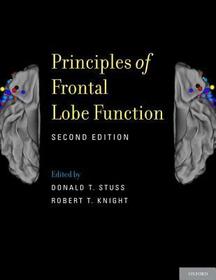
Principles of Frontal Lobe Function
-
10% KEDVEZMÉNY?
- A kedvezmény csak az 'Értesítés a kedvenc témákról' hírlevelünk címzettjeinek rendeléseire érvényes.
- Kiadói listaár GBP 350.00
-
167 212 Ft (159 250 Ft + 5% áfa)
Az ár azért becsült, mert a rendelés pillanatában nem lehet pontosan tudni, hogy a beérkezéskor milyen lesz a forint árfolyama az adott termék eredeti devizájához képest. Ha a forint romlana, kissé többet, ha javulna, kissé kevesebbet kell majd fizetnie.
- Kedvezmény(ek) 10% (cc. 16 721 Ft off)
- Kedvezményes ár 150 491 Ft (143 325 Ft + 5% áfa)
Iratkozzon fel most és részesüljön kedvezőbb árainkból!
Feliratkozom
167 212 Ft

Beszerezhetőség
Megrendelésre a kiadó utánnyomja a könyvet. Rendelhető, de a szokásosnál kicsit lassabban érkezik meg.
Why don't you give exact delivery time?
A beszerzés időigényét az eddigi tapasztalatokra alapozva adjuk meg. Azért becsült, mert a terméket külföldről hozzuk be, így a kiadó kiszolgálásának pillanatnyi gyorsaságától is függ. A megadottnál gyorsabb és lassabb szállítás is elképzelhető, de mindent megteszünk, hogy Ön a lehető leghamarabb jusson hozzá a termékhez.
A termék adatai:
- Kiadás sorszáma 2
- Kiadó OUP USA
- Megjelenés dátuma 2013. január 31.
- ISBN 9780199837755
- Kötéstípus Keménykötés
- Terjedelem800 oldal
- Méret 216x279x42 mm
- Súly 2114 g
- Nyelv angol 0
Kategóriák
Rövid leírás:
Principles of Frontal Lobe Function, Second Edition is an expanded volume, divided into 9 sections representing major research and clinical disciples, including new topics such as social neuroscience. This book will provide clinicians, researchers, and students with the most current information as the mystery of the frontal lobes is unraveled.
TöbbHosszú leírás:
The second edition of Principles of Frontal Lobe Function is a newly organized, and thoroughly updated, volume divided into 9 different sections, each co-edited by leaders in the specific domain of frontal lobe research. The topic areas include anatomy and neuropharmacology, development, systems and models, fundamental cognitive mechanisms, social behavior, clinical neuropsychology, aging, psychiatric disorders, and rehabilitation. This organization reflects both an increase in our combined knowledge about frontal lobe functioning through new imaging technologies, as well as the expansion of the field as a whole to include new topics such as social neuroscience that were not discussed in the first edition.
Principles of Frontal Lobe Function will naturally be of particular interest to researchers and clinicians actively investigating how the frontal lobes operate and to understand dysfunction as a means to design treatment. This new edition will also be a useful resource for anyone involved in a discipline related to brain function, whether it be cognitive neuroscience, behavioral neurology, neuropsychiatry, neuropsychology, or neurorehabilitation. Our knowledge of how the frontal lobes are integrated with functioning in every other region of the brain is also integrating our approach to solving brain-based problems.
Authors in this volume represent investigators who are deep-rooted in frontal lobe research. As such, students will be exposed to both the classical and frontier perspectives and will gain significant insight into future research directions of what we believe to be the most fascinating area of the brain.
This is a marvellously updated edition of a classic reference on the frontal lobes. Anyone interested in the brain and behaviour should be referring to this book. I highly recommend it!
Tartalomjegyzék:
1. Donald T. Stuss and Robert T. Knight
Introduction: Past and Future
2. Joaquin M. Fuster
Cognitive Functions of the Prefrontal Cortex
SECTION I: NEUROANATOMY and NEUROPHARMACOLOGY
Introduction to Section I: Helen Barbas & Trevor Robbins
3. Helen Barbas, Jamie G. Bunce, & Maria Medalla
Prefrontal Pathways that Control Attention
4. Amy F.T. Arnsten
Fleeting Thoughts: Molecular Vulnerabilities in Prefrontal Cortical Circuits
5. Trevor W. Robbins
Optimising the Executive: Neurochemical Modulation of the Fronto-Executive 'Toolbox'
6. Jonathan D. Wallis & Steven W. Kennerley
The Functional Role of Reward Signals in Different Prefrontal Areas
7. Michael Petrides
The Mid-Dorsolateral Prefronto-Parietal Network and the Epoptic Process
SECTION II: FRONTAL LOBE DEVELOPMENT
Introduction to Section II: Silvia Bunge and Arthur Toga
8. David A. Lewis & Darlene Melchitzky
Postnatal Development of Neural Circuits in the Primate Prefrontal Cortex
9. Vicki Anderson & Megan Spencer-Smith
Children's Frontal Lobes: No Longer Silent?
10. Jay N. Giedd, Armin Raznahan, & Rhoshel K. Lenroot
Adolescent Frontal Lobes: Under Construction
11. Allyson P. Mackey, Rajeev D.S. Raizada, Silvia A. Bunge
Environmental Influences on Prefrontal Development
12. Jessica A. Church, Steven E. Petersen, & Bradley L. Schlaggar
Development of Cortical Networks for Top-Down Control
13. Kai Hwang & Beatriz Luna
The Development of Brain Connectivity Supporting Prefrontal Cortical Functions
14. Yuko Munakata, Christopher H. Chatham, & Hannah R. Snyder
Mechanistic Accounts of Frontal Lobe Development
SECTION III: SYSTEMS/MODELING
Introduction to Section III: Earl Miller and Masataka Watanabe
15. Masataka Watanabe
How Context Impacts Cognitive and Motivational Control of Behavior in the Primate Prefrontal Cortex
16. Xiao-Jing Wang
The Prefrontal Cortex as a Quintessential "Cognitive-Type " Neural Circuit: Working Memory and Decision Making
17. Keiji Tanaka, Kenji Matsumoto, Farshad A. Mansouri, & Mark Buckley
Functional Division Among Monkey Prefrontal Areas in Goal-directed Behavior
18. Daeyeol Lee, Soyoun Kim, & Hyojung Seo
Role of Prefrontal Cortex in Reinforcement Learning and Decision Making
SECTION IV: COGNITIVE NEUROSCIENCE
Introduction to Section IV: John Duncan and Etienne Koechlin
19. Etienne Koechlin
Motivation, Control and Human Prefrontal Executive Function
20. John Duncan & Earl K. Miller
Adaptive Neural Coding in Frontal and Parietal Cortex
21. John P. O'Doherty
Functional Contributions of the vmPFC in Value-based Decision Making
22. Katsuyuki Sakai
Network-Based Mechanism of Prefrontal Control
23. Franz-Xaver Neubert, Rogier B. Mars, & Matthew F. S. Rushworth
Is there an Inferior Frontal Cortical Network for Cognitive Control and Inhibition?
SECTION V: SOCIAL NEUROSCIENCE
Introduction to Section IV: Daniel Tranel
24. Giacomo Rizzolatti, Leonardo Fogassi, Giuseppe Luppino, & Stefano Rozzi
The Cognitive Motor System
25. Erik Asp & Daniel Tranel
False Tagging Theory: Toward a Unitary Account of Prefrontal Cortex Function
26. Jessica R. Cohen, Elliot T. Berkman, & Matthew D. Lieberman
Intentional and Incidental Self-Control in Ventrolateral PFC
27. Jennifer S. Beer & Jamil P. Bhanji
Dynamic Social Judgment: The Frontal Lobes and Beyond
28. Steven W. Anderson & Daniel Tranel
Social Outcome Following Early-Life Damage to Prefrontal Cortex
SECTION VI: NEUROPSYCHOLOGY
Introduction to Section VI: Paul Burgess and Jordan Grafman
29. Tim Shallice & Susan Gillingham
On Neuropsychological Studies of Prefrontal Cortex: The ROBBIA Approach
30. Lesley K. Fellows
Decision-making: Executive Functions Meet Motivation.
31. Emmanuelle Volle, Richard Levy, & Paul W. Burgess
A New Era for Lesion-Behavior Mapping of Prefrontal Functions
32. Paul W. Burgess & Hsuan-Chen Wu
Rostral Prefrontal Cortex (Area 10): Metacognition in the Brain
33. Jordan Grafman
Beliefs Sculpt Human Social Identity
SECTION VII: AGING and PREFRONTAL FUNCTION
Introduction to Section VII: Patricia Reuter-Lorenz and Cheryl Grady
34. Brenda A. Kirchhoff, Staci E. Smith, & Jessica D. Luntz
Prefrontal Cortex and Self-Initiated Encoding Strategy Use in Healthy Younger and Older Adults
35. Monica Fabiani & Gabriele Gratton
Aging, Working Memory, and Attention Control: A Tale of Two Processing Streams?
36. Adam Gazzaley
Top-down Modulation and Cognitive Aging
37. Ulman Lindenberger, Agnieszka Z. Burzynska, & Irene E. Nagel
Heterogeneity in Frontal-lobe Aging
38. Roberto Cabeza & Nancy A. Dennis
Frontal Lobes and Aging: Deterioration and Compensation
SECTION VIII: PSYCHIATRIC and NEUROLOGICAL DISORDERS
Introduction to Section VIII: Cameron S. Carter
39. Cameron S. Carter
Prefrontal Cortex and Impaired Cognition and Behavior in Schizophrenia
40. Helen Mayberg
Tuning Mood Circuits with Deep Brain Stimulation: A New Treatment Strategy for Depression
41. William W. Seeley
Selective Vulnerability in Behavioral Variant Frontotemporal Dementia
42. Robert W. Levenson
Selfless Cells: Frontotemporal Lobar Degeneration and Emotional Functioning
SECTION IX: NEUROREHABILITATION
Introduction to Section IX: Ian H. Robertson & Mark D'Esposito
43. Lars Nyberg & Lars Bäckman
Training of Aging Frontal Lobes: Possibilities and Constraints
44. RuchikaShaurya Prakash, Michelle W. Voss, & Arthur F. Kramer
Physical Activity Effects on Brain and Behavior
45. Mark D'Esposito & Anthony J.-W. Chen
Remediating Frontal Lobe Dysfunction: From Bench to Bedside
46. Ian H. Robertson & Brian Levine
Attention and Arousal in Neurorehabilitation
SECTION X: OVERVIEW
47. Robert T. Knight and D.T. Stuss
From the Past to the Future





